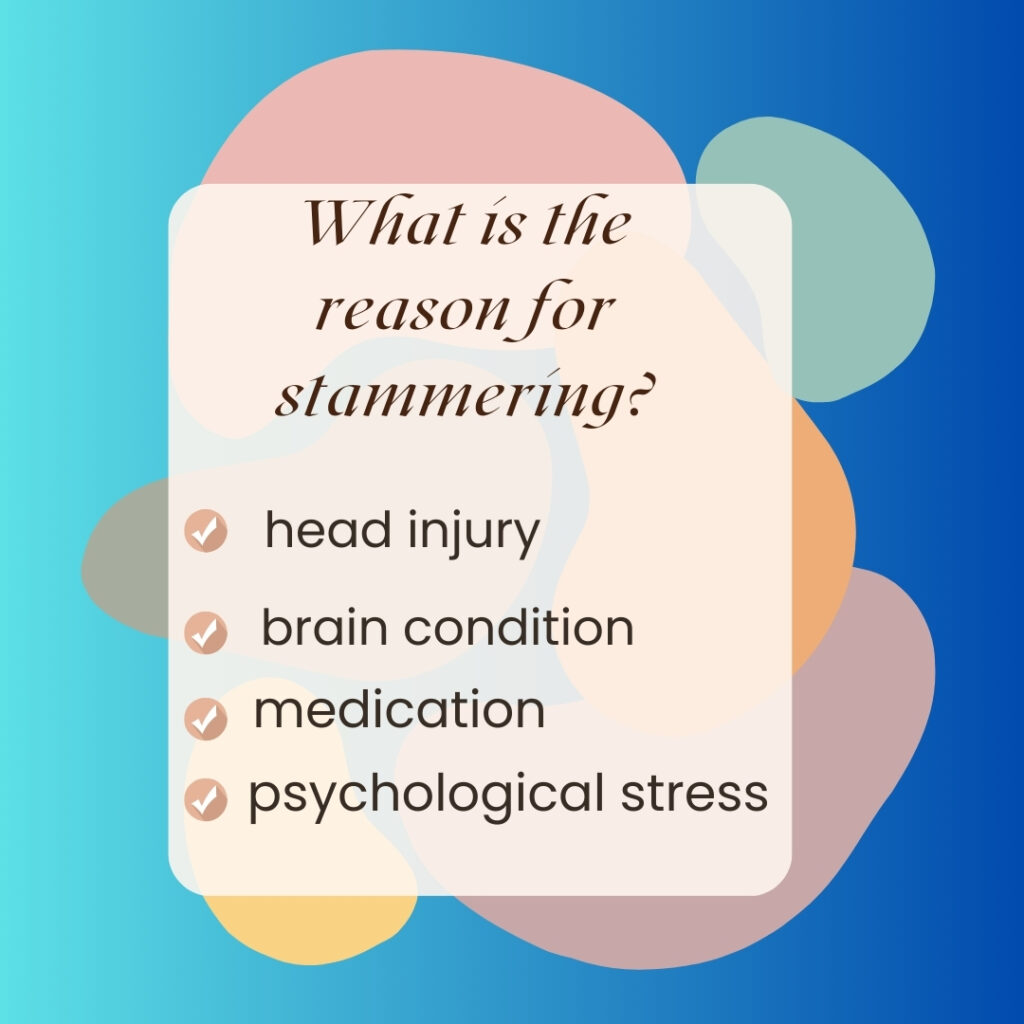Introduction
Stammering is a speech disorder (getting stuck on a word, like repetitions, prolongations, or blocks). One percent of the world’s population suffers from it, but people do not know what it is or its treatment.
This article guides you on how to get rid of stammering problem.
How To Get Rid Of Stammering Problem
- Stammering is a speech problem that affects people from childhood to adulthood. It may not be 100% cured, but it can be significantly controlled. Starting speech therapy early in childhood can be a game changer — the sooner the support begins, the better the results. Lidcombe program, direct and indirect treatment, slow speaking practice, and mindfulness techniques are helpful for the child.
- CBT psychological support also controls your fear and anxiety. DAF devices work for some people. But the most important thing is support. Family support can provide you with a comfortable environment. With regular practice and support, you can cure your stammering.

how to get rid of stammering problem
Let’s understand how to get rid of stammering problem through effective speech therapy.
Speech Therapy For Stammering
Speech therapy mainly aims to enhance verbal flow and address emotional challenges in speech. Treatment includes personalized plans, fluency improvement methods like slow speaking and breathing exercises, and emotional support. This solution has helped change the mindset and improve parent- child interaction. For children and adults, therapy’s primary focus is to reduce stammering, improve communication, and increase self-confidence. Speech therapy is the best answer for people who want to know how to get rid of stammering problem effectively.
Best Medicine For Stammering
Allopathic Medications:
1. Propranolol (Beta-blocker):
- It calms the mind and steadies the body — easing tremors, slowing the heartbeat, and keeping anxiety in check.
- It helps to reduce stammering, especially in public speaking.
2. Alprazolam (Xanax) (Anti-anxiety medication):
- It reduces the symptoms of stuttering and speech anxiety.
- Improve fluency in managing anxiety.
3. Citalopram (Celexa) (Selective Serotonin Reuptake Inhibitor):
- Reduce the core symptoms of stuttering.
- It helps to treat depression and anxiety.
4. Clomipramine (Anafranil) (Tricyclic Antidepressant):
- Reduce the stuttering because of serotonergic properties.
- Control the anxiety and obsessive behaviour, which increases the stuttering.
These medicines may provide short-term relief and support in how to get rid of stammering problem.

Best medicine for stammering
Homeopathic Medications:
1. Stramonium or Jimsonweed:
- If you feel intense fear or anxiety, then this medicine can help you.
- Control fear and nervousness to improve fluency.
2. Kali Phos:
- Reduce mental exhaustion, stress, and anxiety.
- If stuttering is caused by mental fatigue, this remedy may be helpful for you.
3. Lycopodium:
- Address the weakness of self-confidence and hesitation.
- It is also beneficial whenever you feel self-doubt or nervousness.
Medicine does not cure stammering 100%, but it may support those searching for how to get rid of stammering problem, especially in high-pressure situations.
Food that cures stammering
Stammering does not have a scientifically proven “diet cure“, but some food helps indirectly support speech fluency for mood, brain function, and the nervous system.
- Vitamin B1 (Thiamine):
This vitamin is essential for the nervous system. Its source is whole grains, nuts, seeds, and legumes like Kidney Beans and chickpeas.
- Omega-3 Fatty Acids:
It is best for the brain and helps with speech clarity. It is found in fatty fish (like salmon and tuna), walnuts, and flax seeds.

food that cure stammering
- Magnesium-Rich Foods:
It reduces anxiety, which increases stammering, and is found in spinach, pumpkin seeds, and dark chocolate.
- Iron & Zinc:
It is essential for brain development. It is found in lean meats, eggs, beans, and whole grains.
- Hydration:
Drinking less water causes the tongue and throat to dry, which can give you problems speaking. So drinking water a lot is essential.
A balanced diet also supports your journey on how to get rid of stammering problem.
Stammering treatment for adults
- Stammering in adults is a speaking problem that affects confidence, social life, and mental health. Sometimes, this problem is automatically resolved, but treatment is essential if stammering persists into adulthood.
- Speech and Language Therapists (SLTs) are beneficial for this. They make a personalized plan that improves your speaking fluency and give tips for handling speaking situations.
- Instead of this, Cognitive Behavioural Therapy (CBT), Solution-Focused Brief Therapy (SFBT), and Neurolinguistic Programming (NLP), like psychological therapies, also benefit from this. These solutions do not directly treat stammering but handle anxiety and low-confidence issues.
- Electronic feedback devices like DAF (Delayed Auditory Feedback) and FSAF (Frequency-Shifted Auditory Feedback) also greatly benefit; these devices increase fluency.
- Support groups like Stamma are also available to provide speech practice and motivation. Overall, a combination of therapy plus emotional support is instrumental.
Adults who stammer can improve fluency and regain confidence with proper treatment and support. This is how to get rid of stammering problem in adulthood.
Stuttering treatment for child
1. The right approach to treatment
- Medical care is not enough; emotional and behavioural support is also essential.
2. Role of Parents
- First, learned that stuttering is not a character flaw.
- It is a manageable condition that can be controlled with the proper treatment.
3. Importance of speech therapy
- Regular sessions with a child’s Speech-language pathologist (SLP) can improve fluency.
- Methods like fluency shaping and stuttering modification are beneficial.
4. Home-based exercises:
- Daily deep breathing, slow speech practice, and mirror reading exercises are also helpful.
5. Emotional support:
- Positive reinforcement, not interrupting, and listening patiently to parents and caregivers is necessary.
6. Parental involvement:
- When parents and therapists join forces, growth happens faster and more smoothly.
8. Individualized approach:
- Every child is unique, so maintaining patience and consistency is very important.
9. Advantage of early intervention
- Starting treatment early lays the groundwork for clear, confident, and fluent communication later in life.
Early guidance can set the foundation for how to get rid of stammering problem in children.
How to stop stuttering when nervous
Whenever you feel nervous, then stuttering increases because of tension and anxiety. To control this, firstly, take a deep breath so that your nervous system becomes calm. Deep breathing exercises, like the 4-7-8 technique, help you decrease anxiety and smooth your speech. Slow your speech and take pauses so that it reduces your anxiety and does not block your words.
Mindfulness and body awareness techniques also help to understand the tension and help to release your speech more smoothly. Accepting your stutter is also very important, as it prevents you from controlling your speech. Speech therapy, including CBT, also addresses anxiety and boosts your confidence. Speech practice in low-pressure situations, talking with other stuttering patients, and using speech therapy apps can improve fluency. Ultimately, making peace with your stutter instead of battling it can ease the fear and help you feel more at ease while speaking in front of others.
What is the reason for stammering?
The stammering problem starts between 2 and 5 years old when they begin speaking fast and learn the language. The exact reason for this problem is still not found, but according to research, there are many factors of stammering. Genetics is a strong factor— 60% of people suffer from this. The brain’s speech-related areas have subtle differences that are influenced by various factors.
Emotions and anxiety can trigger more, but they can not be the root cause. In adults, stammering can start because of head injury, brain condition, medication, or psychological stress. Every case is different, and the causes are tough to know in some cases. Stammering is not the fault of anyone.

What is the reason for stammering
Type of stammering:
There are three types of stammering: developmental, neurogenic, and psychogenic.
- Developmental stuttering is very common and generally occurs in 2-6-year-old children. This stuttering is a natural recovery, but if it runs long, then you may need speech therapy.
- Neurogenic stuttering occurs when the nervous system gets damaged, like in the case of a brain injury or stroke, which affects speech control. It’s treated with speech therapy and meditation.
- Psychogenic stuttering is a rare type of stuttering that occurs due to emotional stress or trauma. It is treated with speech therapy and psychological counselling.
FAQ
1. Can 100% stammering be cured?
Stammering’s permanent solution is not possible, but it can be managed with the help of speech therapy, behavioral therapy like the Lidcombe Program, and emotional support.
2. Is stammering a disability?
If stammering impacts everyday activities, it may be recognized as a disability. According to UK law, if a significant challenge is created, you can make a reasonable adjustment, such as work, school, or an interview. Some people understand it as disability, and some people understand it as a difference. The medical model thinks about fixing it, although the social model highlights that it is a social barrier.
So, if you’re asking yourself how to get rid of stammering problem, remember — early support, consistent therapy, and patience are the keys.